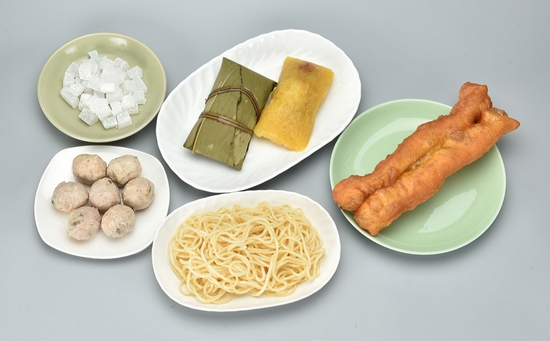
Food Safety Focus (131st Issue, June 2017 ) – Incident in Focus
Abuse of Boric Acid and Borax in Foods
Reported by Ms. Michelle CHAN, Scientific Officer,
Risk Assessment Section,
Centre for Food Safety
The Centre for Food Safety (CFS) released the surveillance results on rice dumplings in April and May 2017. Two loose-packed “gan shui” (lye water) rice dumpling samples were found to contain boric acid, a non-permitted preservative, at levels of 500 ppm and 350 ppm respectively. This article discusses the uses, safety and regulatory control of boric acid and borax in foods.
Uses of Boric Acid and Borax
Both boric acid and borax are boron-containing compounds. Boric acid and borax are used in a wide variety of consumer products such as detergents, adhesives, fertilisers, etc. As early as 1870s, before
countries began legislating against their application as food additives due to their toxicities, boric acid and borax were added to foods as preservatives which inhibit the growth of microorganisms, in particular yeasts, and to a much lesser extent, against moulds and bacteria.
In past years, cases regarding the abuse of borax or boric acid in foods including rice dumplings, meat balls, yellow noodles, root starch jelly and fried fritters were reported in Hong Kong and other places such as Mainland China, Taiwan and Malaysia. These chemicals were illegally added in foods not only for the sake of extending the products’ shelf life, but also because they may increase the elasticity and crispiness of foods.

Some food examples have been reported of abusing of boric acid and borax in Asia.
Public Health Significance
Boron can naturally present in certain foods such as fruits and vegetables. The World Health Organization (WHO) has estimated that the average daily boron intake of the population is well within WHO’s suggested safe range of population intake. The Joint FAO/WHO Expert Committee on Food Additives evaluated the safety of boric acid and borax in 1961 and concluded that these compounds were considered not suitable for use as food additives.
Consuming large amounts of boric acid over a short period of time can adversely affect the stomach, bowels, liver, kidney and brain, and may even lead to death. Animal studies revealed that prolonged excessive ingestion of boric acid resulted in adverse developmental and reproductive effects. Among these experimental animals, testicular lesions and impaired fertility had been observed whereas adverse effects on development including decreased foetal body weights, malformations of eyes, central nervous system, cardiovascular system and the skeleton were also demonstrated. Currently, there is no scientific evidence suggesting boric acid is toxic to genes or cancer causing.
Regulatory Control
Provisions for the use of boric acid and borax have not been included in Codex standards. Also, they are not included in the list of additive permitted for use in food in places such as Mainland China, the United States, Canada, Australia and New Zealand. Nevertheless, they are exceptionally authorised in the European Union for use as preservatives in caviar.
In Hong Kong, boric acid and borax are not permitted preservatives under the Preservatives in Food Regulation (Cap.132 BD).
Local Surveillance
Over the past years, the CFS has been monitoring the illegal use of boric acid and borax in different foods including rice dumplings. From January 2014 to May 2017, 727 food samples were collected in which three of them, all as rice dumplings, were detected with boric acid.
Alternatives to Boric Acid and Borax in Foods
In fact, the addition of boric acid and borax in foods is not essential. It can be replaced by adoption of appropriate food processing methods or, if necessary, use of alternatives in accordance to Good Manufacturing Practice (GMP). Examples include quick freezing of rice dumplings to extend shelf life or use of moderate amount of phosphates as humectant and stabiliser in preparing noodles and processed meat products to improve their texture. It is reported in the literature that polyphosphates applied during the preparation of lye water rice dumplings may help enhance elasticity of the dumplings and reduce the adhesiveness between the rice and wrapping leaves.
Key Points to Note
- Boric acid and borax are non-permitted preservatives in Hong Kong.
- Animal studies indicated that prolonged excessive ingestion of boric acid may cause adverse developmental and reproductive effects.
- Alternatives to boric acid and borax are available for preparing foods.
Advice to Public
- Purchase foods from reliable retail outlets.
- Do not use boric acid or borax when making foods on your own.
- Eat a variety of foods in moderation to avoid excessive exposure to chemicals from a small range of food items.
Advice to Trade
- Purchase food and food ingredients from reliable suppliers.
- Do not use boric acid or borax when preparing foods. Replace with alternatives or adopt appropriate food processing methods as necessary.
- Make sure food for sale complies with local regulatory requirements and adhere to GMP in food preparation.

